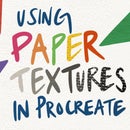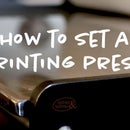Introduction: Make a Pamphlet Stitch Sketchbook
In this tutorial you'll how to sew a simple pamphlet stitch sketchbook or journal. I’m go through a few different methods for both three hole and five hole journals covered with old paper artworks.
Be sure to watch the video to see the binding methods. It can be much easier to understand what's happening with bookbinding when you see it in action.
Supplies
A sheet of paper. My examples used Somerset Velvet 250gsm and Zerkall 120gsm printmaking papers (both brands are around 56x76cm in size)
For the cover, choose a heavier weight decorative or printed paper heavier 200gsm
Bone folder
Ruler
Calculator (if needed)
Cutting mat
Awl
Thread
Beeswax (optional)
Sewing needle
Step 1: Finding the Grain of Your Paper
You can use any paper you like to make your journal. If you’re using a large 56x76cm piece of art paper like me, it’s good to check the grain of the paper before you tear it down to size, as your book will be easier to fold and more structurally sound if you fold the spine in the same direction that the grain runs.
To check the direction of the grain, bend the paper lightly in half in each direction. You’ll see which way the grain runs when you bend it and it has less bounce and settles more easily.
When you know which way your grain runs, you’ll be able to figure out the most suitable way to tear your paper.
Step 2: Preparing Your Paper
If you want to, you can measure out your paper so that you end up with a specific book size, but I find it easier and quicker to just work with the size of the paper.
To tear your paper, bend it lightly and make some little pinch folds where you want to tear it, then line up a steel ruler and make the tears. You could cut your paper with a blade if you want to, but I find that a torn edge looks nicer and is a bit more forgiving for this type of book.
For my smaller 3-hole book, I tore my sheet of paper in half along the short edge, then tore the resulting strips in half again so that I was left with four thin strips of paper. I tore these once more in the opposite direction so that I end up with 8 equally sized pieces. The paper that I used was a 250gsm Somerset printmaking paper, and because it’s quite thick I only used four of the sheets in each book, so the one sheet of paper torn down was enough for two small sketchbooks.
When your paper is all torn down to size, it’s time to fold your signatures. With thick pieces of paper, I like to fold them in half one at a time using a bone folder to make the edge nice and crisp. If you don’t have a bone folder, you can just make the edge as sharp as you can with your fingers. If you’re folding lighter weight paper, you might be able to get away with folding multiple sheets together at once, but I recommend going slowly and folding one at a time.
A signature is the name for a single section of pages in a book. The pamphlet stitch books we’re making today are single signature books, meaning they just have one section of pages inside. Pamphlet stitch is not really suitable for thicker books with multiple signatures, unless you get fancy and creative with your spine. Depending on the thickness of your paper, it’s best to stick to signatures made from four to eight sheets of paper.
Step 3: Preparing Your Covers
I made the covers for my book from old prints that I’ve made in the past. When you find a covering paper that you like, measure it against the signature and tear it down to a size just slightly larger than the pages of the book.
Step 4: Choosing and Preparing Your Thread
Back when I worked in art supply shop, people would come in thinking that they had to use a very specific type of thread to sew their books together. While linen thread is traditional and pretty strong, you really can use any kind of thread you want to, although try to avoid any thread that’s too fine, as it will break more easily.
For the books in the examples, I used a cotton thread cut to a length just over two times the height of the book.
Waxed thread will be less likely to tangle and is a bit easier to work with, but again, it doesn’t matter too much. If you’ve got some beeswax or a beeswax candle handy, you can run your thread through it a few times to coat it.
Step 5: Punching Holes in the Spine
For a 3-hole book, start by marking out the holes in the spine with your awl lightly on one of the sheets of paper. I place a ruler up against the gutter of the spine, and if necessary, I use a calculator to make sure my measurements are accurate.
Make one hole in the centre, then one hole at the bottom about three centimetres in, and another at the top three centimetres in. Once you've lightly marked the spots for the holes with your awl, gather the whole signature together and carefully poke the awl through the whole stack at the same time.
Repeat this process with one of the pages and the cover of the book, then gather everything together again in a stack.
The process is exactly the same for marking and making the holes for a 5-hole book. You'll just need to adjust your measurements to accommodate five holes.
Step 6: Sewing a 3-hole Book
Some people find it easier to clamp their books together with bulldog clips before making their holes in the spine so that it’s easier to line everything up and sew. I tend not to work that way, but give it a go if you think it will make things easier for you.
Sew your pamphlet stitch books from the inside out, starting with the centre hole.
Take your threaded needle through the centre hole to the outside, leaving a decent tail of thread on the inside of the book.
From there, move down to the bottom hole on the outside of the book, and bring the thread back through it to the inside of the book.
When you have your thread back inside the book, skip across the centre hole and take your needle back to the outside of the book through the top hole.
Finish of the sewing by coming back through the centre hole from the outside to the inside.
Pull the threads taut in the direction of the spine to make sure there's no slack anywhere in your sewing.
Before you tie your final knot, make sure that your two thread ends are hanging to either side of the sewn thread in the centre, then tie those two ends around the sewn thread using a square knot. You can tuck your knot and thread ends in if you want to. I like to trim mine lightly with a generous amount of thread left and I just leave them hanging in the centre page of the book.
Step 7: Sewing a 5-hole Book
If you’re making a larger book, you might want to use the five hole binding method so that everything is a bit more secure.
There are a few different ways that you can sew this together, and this is my preferred method.
Like with the three hole book, you start by taking the thread from the inside to the outside of the book through the centre hole, leaving a generous tail of thread.
Instead of going back through the bottom hole, go back in through the next hole down, which should be the second hole from the bottom.
When you have the thread back inside the book, take it out again through the bottom hole.
Now it’s time to turn it around and move gradually up the book. Bring the thread back through the second to bottom hole once more and to the inside of the book.
Go back out through the centre hole, being careful not to split the thread that you’ve already sewn with your needle.
Come back inside at the second to top hole, then take the thread back to the outside through the top hole.
Come back inside again through the second to top hole, and instead of going back outside the book through the centre hole, just loop your needle and thread through the next stitch down.
Make sure all your stitches are taut, and tie your ends together with a square knot.
Step 8: An Alternative Method for Sewing a 5-hole Book
Another way that you can sew a five hole pamphlet book together is to use two shorter threads, using exactly the same method that we used for the three hole book, but repeating it twice. There’s no one way to sew any book together, so please experiment and have fun with it.
And that’s how you make both three hole and five hole pamphlet stitch books! Be sure to watch the video to see the binding methods. It can be much easier to understand what's happening with bookbinding when you see it in action.





